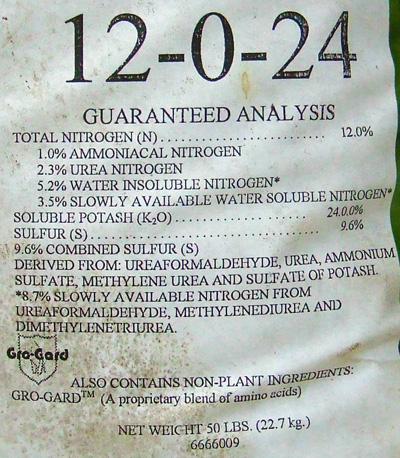So, here are my answers:
(1) What are the source ingredients for Nitrogen (N) in the fertilizer?
The Nitrogen sources are the various forms of Urea, and some Ammonium Sulfate. The differences in Urea forms are to either stabilize it, or to slow its release over a longer timeframe.
(2) What are the source ingredients for Phosphorus (P) in the fertilizer?
There is no Phosphorus in the fertilizer. The zero in the second NPK number tells us that.
(3) What are the source ingredients for Potassium (K) in the fertilizer?
The Potassium (K) is coming from Sulfate of Potash ("SOP"), also known as Potassium Sulfate. Just saying "Potash" isn't good enough - Sulfate of Potash is 0-0-50, and its cousin Muriate of Potash ("MOP") is 0-0-61, and much harsher on the soil and microherd -- due to a high Chlorine component. While SOP is significantly more expensive than MOP, it is worth the investment. We will allow some MOP is the early stages of a remediation regimen, but always switch to SOP as the regimen reaches the later stages. This gives the microherd time to recover and participate in handling leaves, compost, and natural/organic sources of nutrients.
(4) If you wanted to apply no more than 1 lb/K of any N, P (as P2O5) or K (as K2O) in a single application, how much of the fertilizer should you apply?
You should apply no more than 4.166 lbs per 1000 sq ft of the fertilizer, as the 24% of Potassium (as K2O) will reach 1 lb/K first.
(5) How much Nitrogen would be applied by the application in Question #4?
You will apply 0.5 lbs/K of Nitrogen with that application.
(6) How much Nitrogen is in the 50 lb bag?
6 lbs (calculated by multiplying 50 lbs by the 12% that is the Nitrogen components.
Any questions before we move on?
